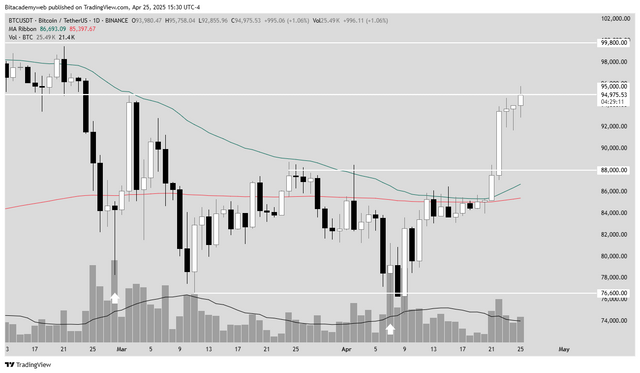Despite the drop in US consumer confidence, Bitcoin is advancing toward the key resistance of $95,000, driven by optimism regarding the trade truce and growing investor interest.
The price of Bitcoin (BTC) continues its upward trend this Friday, registering a 1.06% increase at the time of this report and trading at $94,975. The world's leading cryptocurrency is testing the crucial resistance zone of $95,000, reaching an intraday high of $95,758. This advance occurs amid expectations of an easing of the tariff war between China and the United States, providing some relief to risk-averse markets, while a report on declining US consumer confidence generates diverse interpretations of its impact on digital assets.

Bitcoin price resumed its uptrend, maintaining positive sentiment by trading above the 50- and 200-period exponential moving averages / TradngView
US Consumer Confidence: A Double-Edged Sword for Bitcoin?
The final Michigan Consumer Sentiment Index for the current period stood at 52.2, exceeding the consensus of 50.8 but falling short of the previous reading of 57. While the figure exceeded initial expectations, suggesting slight consumer resilience to inflationary pressures and economic uncertainty, the decline from 57 reveals a deterioration in consumer confidence over time, possibly due to persistently high inflation, concerns about the labor market or economic growth, and the effects of the restrictive monetary policies implemented by the Federal Reserve (Fed).
In the macroeconomic context, a cautious, but not panicky, consumer could put pressure on discretionary spending, affecting cyclical businesses. If this downward trend in consumer confidence persists, it could herald an economic slowdown, which could reduce inflationary pressures in the medium term. For the US dollar (USD), this data generates a neutral to slightly negative outlook, as lower confidence could weaken expectations of a strong US economy, although rate spreads could contain a sharp decline.
As for cryptocurrencies such as Bitcoin and Ethereum, their sensitivity to liquidity puts them in an interesting position. If the market interprets the confidence data as a signal for a possible "pivot" or change of direction in the Fed's monetary policy, we could see a partial rally in risk assets. Conversely, if no change in the Fed's stance is perceived, sideways trading could be the norm. However, a weaker dollar, driven by expectations of an economic slowdown, could lead the Fed to accelerate interest rate cuts, which has historically been favorable for risk assets like Bitcoin.
Bitcoin Futures Open Interest Reaches Yearly High
In the futures market, Bitcoin open interest experienced a notable 5.16% increase in the last 24 hours, reaching $68.27 billion. This level represents a new high not seen since January 21, indicating a significant injection of liquidity as the cryptocurrency's price continues its upward trend. This increase in open interest suggests greater investor participation and confidence in the current price movement.
Bitcoin Struggles to Conquer the $95,000 Barrier
The Bitcoin price resumed its upward trend, maintaining positive sentiment by trading above the 50- and 200-period exponential moving averages. The world's leading cryptocurrency is currently attempting to overcome the key resistance at $95,000. A consolidation above this level would open the door to the next resistance zone, located near the psychological threshold of $100,000. Trading volume on the Binance exchange exceeded the 25-day average, suggesting that the bullish movement has significant support from buyers.
Despite the caution reflected in the US consumer confidence data, Bitcoin is showing notable strength as it advances toward the crucial resistance of $95,000. Optimism regarding a potential trade detente between China and the US, coupled with growing open interest in futures, fuels expectations of a significant upward movement. However, investors should remain attentive to upcoming US inflation (PCE) and employment data, which will be crucial to confirm whether the weakening consumer confidence translates into less price pressure or a greater risk of recession, factors that could influence Bitcoin's trajectory in the medium term.
Disclaimer: This analysis is for informational purposes only and does not constitute financial advice. Cryptocurrency trading is highly volatile and carries significant risks, including the total loss of your invested capital. Consult a financial advisor before making any investment decisions.
Upvoted! Thank you for supporting witness @jswit.
Downvoting a post can decrease pending rewards and make it less visible. Common reasons:
Submit